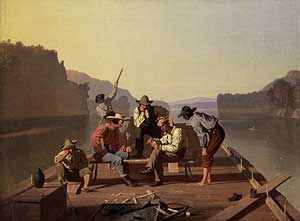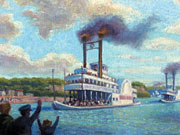| The Grand Excursion |
|
Audio
Photos
More from MPR
Resources
Your Voice
|
Currents of Change: art and the Mississippi in the 1850s
June 29, 2004
 |
| George Caleb Bingham (1811-79) "Raftsmen Playing Cards," 1847 (Image courtesy of the Saint Louis Art Museum) |
 | |||
Minneapolis, Minn. — Of all the words written about the Mississippi Valley in the 1850s, perhaps the most famous are by Henry Wadsworth Longfellow.
"On the shores of Gitche Gumee, Of the shining Big-Sea-Water, Stood Nokomis, the old woman, Pointing with her finger westward..." Longfellow's poem, "Song of Hiawatha" caused huge excitement when it was published.
Minneapolis Institute of Arts Senior Curator Christopher Monkhouse says Longfellow was inspired by artwork about the Mississippi River Valley.
"His ideas have to come from somewhere," Monkhouse says. "They are rooted here even though he didn't come here. But he read about these things. He had a Dakota dictionary at his hand. He saw water colors, he saw daguerrotypes and dioramas. And it's through that material he learns about the story of Winona, the first-born who throws herself from a cliff. So this is all fodder, all this early material is all fodder for later developments."
 | |||
Visitors can see the artistic evolution that followed in "Currents of Change." The MIA show explores the artwork that may have influenced Longfellow and others during a crucial time in the nation's history -- the mid-1850s.
That was when the Grand Excursion sailed up the Mississippi River bringing tourists and new commerce to Minnesota. That was also when the economy of the Mississippi River Valley began changing from sugar and cotton to lumber and flour-milling. Assistant Curator Jason Busch says the exhibit's title, "Currents of Change," has real meaning.
"The title truly came from this dramatic period of development in America in the 1850s and these currents of change can truly be seen in the Mississippi Valley," Busch says. "From the end of an era with the steamboat and the beginning of the railroad and an economy that was shifting ever more so toward industrialization."
The exhibit contains fine and decorative art from Louisiana to Minnesota. There are prints and paintings, but the exhibit is more than just oil on canvas. It also features textiles, fine glass, sculpture and silver.
 | |||
One of the most unusual pieces is a panorama. It's a long panel of painted scenes, mounted on rollers. Patrons could sit and watch the scenes roll by as a narrator told a story. Busch says attending a panorama viewing in the 1850s would have been the equivalent of going to the movies today. He says this particular panorama traveled the world telling the story of the Mississippi.
"This panorama is the only one that's remaining, the only extant panorama of the Mississippi River. Owned by the St. Louis Art Museum, it's over 340 feet long, includes 25 scenes from the Ohio and Mississippi river valleys. And it would have been unrolled with a narration," he says.
The panorama is now 150 years old and too fragile for the rigors of a full performance. So, the institute has set up an interactive display using computers that allows visitors to view the roll. "Currents of Change" features 150 sculptures and other objects, including furniture. There's a bureau that was intended for the White House had Henry Clay won the election of 1844 instead of George Polk.
The pieces in the exhibit juxtapose the vanishing frontier against picturesque landscapes that illustrate the change over the years. But assistant curator Jason Busch says, now and in the 1850s, these images had a broad impact.
 | |||
"It really evokes the romantic untouched wilderness that many people thought was just fading away as the frontier was moved increasingly further and further westward during the 1850s with the development of these dense urban centers like New Orleans and St. Louis, but even by the late 1850s, St. Paul and St. Anthony," he says.
The river has changed drastically since the 1850s, but the curators of "Currents of Change" want patrons to get a peek at what drew so many people to the Mississippi River Valley and, Minnesota in particular.
"Currents of Change" is on display at the Minneapolis Institute of Arts until September.
|
News Headlines
|
Related Subjects
|

